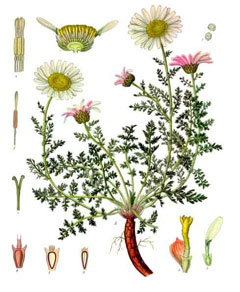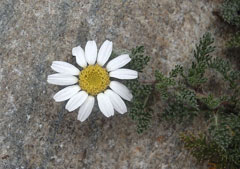 |
|
http://commons.wikimedia.org/wiki/File:Koeh-011.jpg |
 |
| http://commons.wikimedia.org/wiki/User:JerryFriedman |
Translate this page:
Summary
Bloom Color: Red, White, Yellow
Main Bloom Time: Early summer, Late summer, Mid summer. Form: Prostrate, Spreading or horizontal.
Physical Characteristics

 Anacyclus pyrethrum is a PERENNIAL growing to 0.3 m (1ft) by 0.3 m (1ft in) at a medium rate.
Anacyclus pyrethrum is a PERENNIAL growing to 0.3 m (1ft) by 0.3 m (1ft in) at a medium rate.
See above for USDA hardiness. It is hardy to UK zone 6. The species is hermaphrodite (has both male and female organs).
Suitable for: light (sandy) and medium (loamy) soils and prefers well-drained soil. Suitable pH: mildly acid, neutral and basic (mildly alkaline) soils. It cannot grow in the shade. It prefers moist soil.
UK Hardiness Map
US Hardiness Map
Synonyms
Plant Habitats
Cultivated Beds;
Edible Uses
References More on Edible Uses
Medicinal Uses
Plants For A Future can not take any responsibility for any adverse effects from the use of plants. Always seek advice from a professional before using a plant medicinally.
Acrid Antirheumatic Epilepsy Odontalgic
The root is a pungent acrid herb that stimulates the salivary glands and irritates the tissues, thereby increasing blood flow to the area[238]. It is used externally to treat toothache, facial neuralgia and chronic catarrh[238]. A gargle is used to soothe sore throats[254]. The root is harvested in the autumn and dried for later use[238]. In Ayurvedic medicine the root is considered to be tonic and is used in the treatment of paralysis and epilepsy[254]. The diluted essential oil in the root is used in mouthwashes and to treat toothaches[254]. This oil should not be used internally, except under professional supervision[254].
References More on Medicinal Uses
The Bookshop: Edible Plant Books
Our Latest books on Perennial Plants For Food Forests and Permaculture Gardens in paperback or digital formats.

Edible Tropical Plants
Food Forest Plants for Hotter Conditions: 250+ Plants For Tropical Food Forests & Permaculture Gardens.
More

Edible Temperate Plants
Plants for Your Food Forest: 500 Plants for Temperate Food Forests & Permaculture Gardens.
More

More Books
PFAF have eight books available in paperback and digital formats. Browse the shop for more information.
Shop Now
Other Uses
References More on Other Uses
Cultivation details
Landscape Uses:Alpine garden, Rock garden. Requires a well-drained soil in full sun[200]. Plants are intolerant of excessive wet, especially in the winter, and will do better if covered by a pane of glass in the winter[200]. This species is hardy to at least -5°c, probably more if the ground is very well-drained[200]. Special Features:Not North American native, Extended bloom season in Zones 9A and above.
References Carbon Farming Information and Carbon Sequestration Information
Temperature Converter
Type a value in the Celsius field to convert the value to Fahrenheit:
Fahrenheit:
The PFAF Bookshop
Plants For A Future have a number of books available in paperback and digital form. Book titles include Edible Plants, Edible Perennials, Edible Trees,Edible Shrubs, Woodland Gardening, and Temperate Food Forest Plants. Our new book is Food Forest Plants For Hotter Conditions (Tropical and Sub-Tropical).
Shop Now
Plant Propagation
Seed - requires about 3 weeks cold stratification. Germination is best at a temperature around 13 - 16°c[238]. Prick out the seedlings into individual pots when they are large enough to handle and grow them on in the greenhouse for their first winter. Plant out in late spring or early summer[200]. Cuttings of softwood in the spring[200, 238].
Other Names
If available other names are mentioned here
Native Range
EUROPE: Spain AFRICA: Algeria, Morocco
Weed Potential
Right plant wrong place. We are currently updating this section.
Please note that a plant may be invasive in one area but may not in your area so it's worth checking.
Conservation Status
IUCN Red List of Threatened Plants Status :

Growth: S = slow M = medium F = fast. Soil: L = light (sandy) M = medium H = heavy (clay). pH: A = acid N = neutral B = basic (alkaline). Shade: F = full shade S = semi-shade N = no shade. Moisture: D = dry M = Moist We = wet Wa = water.
Now available:
Food Forest Plants for Mediterranean Conditions
350+ Perennial Plants For Mediterranean and Drier Food Forests and Permaculture Gardens.
[Paperback and eBook]
This is the third in Plants For A Future's series of plant guides for food forests tailored to
specific climate zones. Following volumes on temperate and tropical ecosystems, this book focuses
on species suited to Mediterranean conditions—regions with hot, dry summers and cool, wet winters,
often facing the added challenge of climate change.
Read More
Expert comment
Author
(L.)Link.
Botanical References
200
Links / References
For a list of references used on this page please go here
Readers comment